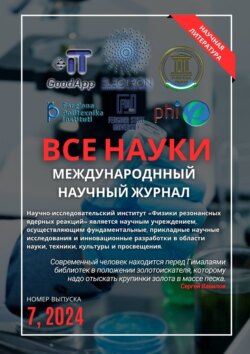Читать книгу Все науки. №7, 2024. Международный научный журнал - Ибратжон Хатамович Алиев - Страница 15
ФИЗИКО-МАТЕМАТИЧЕСКИЕ НАУКИ
ON THE MODERN POSSIBILITIES OF TRANSMITTING A DISCRETE SIGNAL BETWEEN SYSTEMS USING THE TUNNELING EFFECT
Setting the task
ОглавлениеInitially, it is known that the phenomenon is described by the Schrodinger equation in the dynamic representation (1)
The equation involves a potential barrier U (x, t), which is a variable function and depends on multiple parameters – objects that are located between the source and the receiver, which must be overcome by the guided particle. Most often, vacuum prevails in outer space, but there are also quite a few obstacles, for the initial idea, we define the value of the potential barrier as the amount of energy of the mass of all matter located on the communication channel, with an average density of matter in the Solar system. Thus, the communication channel is an imaginary cylinder with a radius equal to the radius of a beam of 10 microns, 42.4 astronomical units long, from which the corresponding volume and mass are calculated, taking into account the average density of matter in the solar system of 0.931*10—26 kg/m3 (2).
And also, based on the height of the potential barrier, it is possible to determine the boundary and initial conditions for the state function of the quantum mechanical system in (3).
The boundary conditions are formed from several statements. For use, such a system is necessary in which the probability of finding the beam after sending it in the radiator should be zero, at the specified target – on the Ground, should be equal to 100 percent. Despite the fact that with classical propagation at a time, taking into account such distance measurement, it is necessary that after 21,157,80283 seconds-meters, the probability of finding the beam on Earth was 100% and zero when reaching the Sun at 21,656,80762 seconds-meters. Based on the obtained indicators with respect to one dimension and time, equation (1) can be solved with the specified boundary conditions (3).
To do this, the Fourier variable separation method will be used, with respect to solving an equation of the form (4), the form of the function (5) will be adopted, where, after substitution, the form (6) is formed, from which 2 separate ordinary differential equations are derived.
The equation is solved in time to the state of the general form, according to (7), but due to the presence of initial conditions in (3), the present form can be solved by means of representation in the form of a system (8), taking into account the finding of the formula-dependence on the independent variables of the general form of the function (9), where after solving the formed equation after substituting the formula of the independent variable, the form of the introduced constant (10) in (6) is formed.
The value of the constant makes it possible to determine the value of the first and, accordingly, the opposite of the second independent constant (11), which, after substituting into the general form of the time function (7), gives its private emerging form (12) and (Fig. 1).
Fig. 1. Graph of the function
To continue the study, after establishing the actual form of the function in time, it is necessary to solve the formed ordinary differential equation with respect to the coordinate, which was obtained in the ratio (6). Since the value for the constant was also obtained in (10), after substitution, a final form of an ordinary differential equation in coordinate is formed, for which there is a constant from the characteristic of the form (13), and then the general form of the function (14).
When forming the problem, boundary conditions were also indicated, the substitution of which allows us to operate from the conclusions of the expression for the third and also opposite, as can be seen from the boundary conditions, independent constant, which in this case has a large-scale appearance, for which a replacement is introduced (15).
Substituting the resulting replacement allows you to ultimately form a simplified view of the function at the coordinate (16).
The result of the study is the assembled form of the function of the quantum mechanical state of the tunneling system. However, in this case, the desired function is initially a probability distribution function, for which only the square of its module has physical meaning. Based on this, it is possible to form the form of the square of the module of the function, as for the boundary conditions to be set, for the reason that initially the problem required complete preservation of information and in the case of data transition to an imaginary space, the boundary conditions were set to the original form of the function, for which the square of the module is represented in (17—18).
Thus, a full-fledged pattern was derived that predicts the probability distribution of finding a response signal for a given case at the maximum distance from the Earth for the probe.
